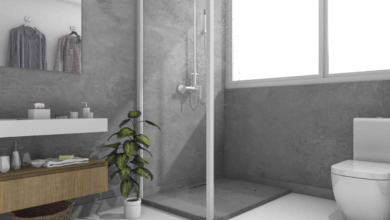Redesigning the Garden: Making Space for Kids, Dogs, and Quiet Moments

There’s a quiet shift happening in backyards around the world. No longer just patches of grass and a few flower beds, gardens are evolving into living, breathing extensions of the home—especially for families raising children alongside four-legged companions.
It’s easy to see why. Inside the house, every room reflects compromise and coordination: toy bins share corners with dog beds, stair gates do double duty, and mealtimes revolve around small hands and wagging tails. But the garden? That’s a blank canvas. It’s where boundaries can soften, routines can find their rhythm, and both child and dog can feel a rare mix of freedom and structure.
More families are taking a long look at their outdoor spaces and asking a new kind of question—not “How do we make this pretty?” but “How do we make this work for everyone?”
The emotional reward is real: a garden where a toddler toddles safely while a dog zooms nearby. Where a shared world unfolds, and no one has to be shushed, fenced in, or left inside. It’s also practical: a well-thought-out outdoor space can reduce indoor mess, support physical development, and promote a better daily flow for parents too.
This article walks you through one full day in a reimagined garden—starting at sunrise and winding down after dark. Along the way, we explore how to build zones that promote safety, creativity, rest, and joy for both the human child and the canine one. It’s not about achieving perfection. It’s about small shifts that make big differences. And the story starts with light on the horizon.
Sunrise Stretch: Safety Meets Freedom
The early hours set the tone. Kids wake curious. Dogs wake ready. Before breakfast, the garden should already feel like an invitation—safe, open, and full of possibility.
Start with boundaries. A fence shouldn’t just keep the dog in and strangers out; it should help the child understand limits too. Horizontal slats can offer visibility while still preventing escape. Natural materials—bamboo, cedar, or thick hedging—maintain an organic look and don’t scream containment. Consider double gates for added peace of mind if you have front garden access, especially with fast movers.
Surfaces matter more than most people realize. Bare dirt invites digging (fun but messy). Concrete is easy to clean but harsh on knees and paws. Grass works, but it wears down. Many families are turning to mixed surfaces: a central patch of artificial turf for durability, flanked by bark chips or clover for a softer, paw-friendly touch. Sand paths or smooth stepping stones also offer tactile variety.
Sunrise light can be sharp. For dogs and young children, harsh glare isn’t pleasant. Strategically placed low hedges, shade-tolerant shrubs, or mesh fabric stretched above key areas can provide dappled protection. You don’t need full coverage—just a few early-morning corners where light filters gently through.
Safety doesn’t have to mean sterile. The real success lies in making the garden feel like open play, even when there are limits built in. At sunrise, the goal is to offer a soft hello to the day—freedom to run, roll, and roam, with no urgent corrections or calls back inside.
Mid-Morning Movement: Paths, Play, and Exploration
By mid-morning, the garden comes alive. Breakfast is done, energy is high, and both kid and dog are itching for action. This is the time to lean into motion—with purpose.
Instead of one big open space, divide the garden subtly. Create loops with natural materials: curved gravel paths that arc around flower beds, stepping stone circuits through tall grasses, or even a winding wooden plank trail for little feet and paws to follow. Movement feels more fun when there’s direction.
Raised beds aren’t just for tomatoes. Position them low enough to allow peek-ins and touch, and suddenly they become mini sensory stations. For kids, they offer early lessons in plant life. For dogs, they’re a perimeter to patrol. Add logs, low boulders, or gentle hills for climbing—this brings in variation and physical challenge without the need for plastic play equipment.
Agility-style features are worth considering, even outside training goals. Think balance beams, tunnel nooks, or weaving poles. Kids crawl through. Dogs dash around. A single repurposed log can become a pirate ship or a scent station.
And don’t forget stillness. Not everything needs to be kinetic. Open spaces are important too—zones for ball-chasing, hopscotch drawing, or lying down and watching clouds. Let movement and pause exist in tandem. The magic isn’t in constant motion, but in the freedom to choose what kind of play comes next.
Lunchtime Light: Shade, Shelter, and Seating
As the sun climbs, so does the need for retreat. This is the garden’s siesta time—a moment to eat, hydrate, and rest. Shade isn’t optional; it’s a design priority.
Natural shade from mature trees is ideal, but not always possible. Low pergolas with climbing vines, triangular sail canopies, or simple umbrellas anchored into raised planters can offer relief. Shade should move with the day, casting new shapes and keeping a few key spots cool.
Now for seating. Forget dainty outdoor sets that can’t take a spilled juice box or a muddy paw. Look instead for dual-use furniture that accommodates both size and chaos. Benches with toy storage beneath. Low stools that double as play tables. Waterproof cushions that invite a nap or a wrestling match.
It’s in these design moments that you may spot elements usually found indoors—or in public spaces. Outdoor dining zones often borrow aesthetic cues from restaurant furniture, particularly when families want durability and clean lines without sacrificing style. A steel-and-teak bistro table, for example, works for morning coffee, toddler painting, and a dog leash loop in one stroke.
Cooling elements don’t need to be fancy. A shallow splash pad gives dogs a way to cool off and toddlers a place to stomp. A shaded sandbox or a small water table near the seating zone keeps hands and paws occupied while adults sip something cold nearby.
This is the hour for shared stillness. Not silence, but slower moments—sticky hands, panting pups, and shade that feels earned.
Afternoon Focus: Nature Play and Mental Stimulation
As the afternoon stretches out, attention spans start to wobble. Instead of fighting it with screens or structured games, guide it toward nature.
This is when quiet corners shine. A log pile teeming with bugs becomes a place of curiosity. A water feature with a small stream trickling into pebbles invites gentle interaction. Dogs lap from the edge. Kids float leaves or splash with sticks. No batteries, no instructions—just organic play.
Sensory gardens aren’t just for aesthetics. Use edible plants—rosemary, mint, lavender—that are safe for sniffing and brushing. Place them at child and dog nose height. Build low digging pits lined with sand or loose soil where dogs can dig without consequence, and kids can scoop, pour, and explore texture.
Consider trellises or tunnels made from bean plants or willow branches. They create boundaries while allowing movement. Kids crawl through them. Dogs dart around them. Everyone learns something about space, form, and patience.
Most importantly, these zones create rest from overstimulation. There’s no soundtrack here. No competition. Just the natural feedback loop of hands in dirt, noses in flowers, and eyes tracking ants.
This hour is for depth—not speed. When both child and dog have a place to follow instincts and curiosity, behavior often improves elsewhere. The afternoon garden becomes a quiet teacher, building attention, respect, and wonder.
Sunset Calm: Wind-Down Zones and Soft Borders
As the light softens, so should the energy. Sunset invites a wind-down, not a shutdown. This is the moment for soft textures, quiet rituals, and shared stillness.
Start with soft borders—literally. Plant tall grasses, ornamental bamboo, or flowering hedges that sway and whisper. They create pockets of privacy without harsh fencing. Within these, nestle cozy zones: a hammock slung between trees, a thick blanket under a leafy arch, or a beanbag in a low corner deck.
This is where rest begins. Dogs curl up. Kids slow down. Some might read, others just watch the sky. Design cues can reinforce this behavior: a cluster of solar-powered lanterns suggests quietness. A low bed or cushion tucked beside a planter tells a dog it’s okay to settle.
Think about lighting. Avoid floodlights unless absolutely necessary. Go with warm-toned LEDs, fairy lights in trees, or motion-sensor path lights that feel gentle rather than jarring.
You can also build in subtle cues for behavior. A patterned stone border might signal a dog not to cross. A soft rug near a seating area might remind a toddler where to sit. Boundaries don’t need to bark. They can whisper.
Sunset in a family garden isn’t about winding everything down. It’s about letting the day dissolve in a way that feels whole. Here, comfort is quiet—and comfort is shared.
After Dark: Safety, Cleanup, and Recharge
Even when the sun disappears, the garden doesn’t. Nighttime brings its own priorities—safety, order, and adult reconnection.
Start with lighting. Keep paths clear with low solar lamps or step lights embedded in borders. Motion-activated lights near entrances can help with last bathroom trips for dogs or one last toy fetch before bedtime.
Storage needs to be fast and intuitive. Bins with lids that a child can open and close. Hooks for leashes and towels. Water bowls tipped out, balls stacked, chalk tucked away. Teach cleanup as part of the rhythm—not a punishment, but a pause.
Parents matter here too. Design a spot just for watching—maybe a wooden deck with a soft chair, maybe a corner bench angled to catch the breeze. A small outdoor heater or warm blanket keeps the chill off. A glass of wine, a tired child nearby, a snoozing dog at your feet. This isn’t luxury. It’s just the reward for building a space that holds you all.
By now, the garden doesn’t feel like a separate space anymore. It’s not the “backyard.” It’s the evening room. The place where energy fades without drama, where everyone—two-legged or four—knows it’s safe to rest.
What They Remember
When we think of childhood or companionship, we often remember places more than toys. We remember dirt under fingernails, the sound of a bark nearby, the warmth of grass after a nap.
Redesigning a garden for both child and dog isn’t about aesthetics. It’s about rhythm, trust, and presence. It’s giving them both room to grow, to rest, to play, to learn. Not through control, but through shape—how space guides behavior, how plants suggest paths, how shade invites pause.
What the child remembers won’t be the brand of the swing or the style of the sandbox. It will be the way the garden made movement feel possible and rest feel deserved. What the dog remembers will be even simpler: this is where I belong, where I am allowed to be.
And for the parent? A garden like this doesn’t reduce your work—but it can change its tone. Fewer interruptions. Fewer risks. More quiet watching. More small, shared victories.
No garden is ever finished. It changes with the seasons, with growth spurts, with new habits. But when designed with intention, it becomes more than a space. It becomes a rhythm. A story. A room without walls.
Let your garden grow with them. Let it teach without words. Let it hold you all, one day at a time.




